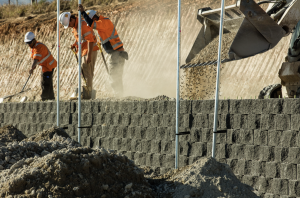Introduced in 2019, Keystone TW3 is a cost-effective, technically advanced and efficient alternative to traditional concrete block retaining walls
When Austral Masonry installed the first Keystone TW3 Retaining Wall at Oakdale South in 2019, it was the tallest concrete block retaining wall in the Southern Hemisphere.
A near vertical wall, it comprised approximately 10,000 square metres of charcoal coloured, split face textured block which stands at 14 metres tall at its highest point.
It was a major development for Austral Masonry, who had been using Keystone’s Compac retaining wall system for a number of years, before seeking a technically superior solution for larger infrastructure projects.
Partnering with Keystone and Geofabrics, Austral Masonry introduced Keystone TW3 to enable engineering of taller retaining walls with improved performance thanks to its mechanically connected geogrid reinforced system.
The Keystone TW3 system has also enabled reductions in construction time and costs on various projects in Australia.
“They’re just some of the major benefits of Keystone TW3,” says Daren Gardiner, Managing Director of Keystone International.
In the UK, Keystone TW3 is by far the most common retaining wall used on large infrastructure projects, he says.
“Since we’ve introduced the product in the Australian market, it’s taken off on major infrastructure projects including roads and highways.”
Keystone TW3 features in the spotlight
Before the introduction of Keystone TW3, Austral Masonry used a simple block and geogrid, relying on the friction of the grid sitting on top of the block, says Gardiner.
“Reinforcing schemes – i.e., the material we’re putting between the layers of soil – would utilise either a positive connection or a frictional connection.”
Using a positive or frictional connection has certain disadvantages, including escalating costs.
“Let’s say you’re designing a 10 metre high segmental retaining wall. Once you take into account the loads on the wall, the grids that need to be laid between the walls would need to be at least 10 metres long. That’s based on the frictional connection and the pullout of the grid.

With Keystone TW3, the grids can be mechanically connected to the unit itself, resulting in fewer grids.
“That’s why it’s so efficient and cost-effective. We’re relying on the frictional and mechanical connection. It can take higher loads and we use fewer grids,” says Gardiner.
The most distinctive feature of the Keystone TW3 is the high-efficiency connection between the facing unit and the geogrid.
Another benefit of Keystone TW3 is its constructibility.
“The product has Keystone pins which allows us to build a structure around very tight corners and curves,” says Gardiner.
“We can place the blocks around the wall and it will just follow the curves.”
Ease of construction with Keystone TW3
Installing Keystone TW3 is a straightforward process, bearing similarity to other segmental retaining wall products.
It doesn’t require skilled labour or cranes and propping, but can be easily and efficiently installed.
“It’s really stacking block on block and as long as you have a suitably qualified supervisor, then you don’t need skilled labourers, so that can really help to keep the price down,” says Gardiner.
“We normally say one worker can install 10 square metres per day. But that’s the slowest the process would be,” says Gardiner. “We’ve seen crews install up to 20 square metres per person per day, so it does vary and is dependent on the particular construction site.”
As the Keystone TW3 is near vertical, it optimises the space available.
“It’s a really efficient, versatile and easy-to-use system.”
To find out more visit australmasonry.com.au

